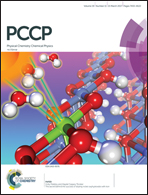Impacts of anions on the oxygen reduction reaction kinetics on platinum and palladium surfaces in alkaline solutions†
Abstract
The fundamental understanding of the impacts induced by anions on oxygen reduction reaction (ORR) in alkaline media is of great importance in the design of more advanced catalysts for alkaline fuel cells (AFC). In this study, the specific adsorption of F−, Cl−, ClO4−, CO32−, SO42−, and citrate anions on Pt/C and Pd/C catalysts, and their impacts on the ORR kinetics in alkaline solutions were systematically studied. It was found that F−, Cl− and ClO4− did not specifically adsorb on Pt or Pd surfaces and had no poisoning effect on ORR. CO32− and SO42− had significant effects on Pt/C and lowered the activity even at a very low concentration. On the other hand, their impacts on Pd/C were negligible. Self-dissociation of citrate anions was found to occur on both Pt/C and Pd/C in the H adsorption/desorption and double layer regions. For the first time, surface enhanced infrared absorption spectroscopy (SEIRAS) with the attenuated total reflection (ATR) technique was used to investigate the self-dissociation of citrate on Pt and Pd thin film electrodes. The breaking of carboxylic groups and the carbon backbone was proposed as a possible dissociation pathway for citrate. The adsorbed species have a negligible effect on ORR activity on Pt/C as they are removed by oxidation before 0.75 V. In contrast, their oxidation on Pd/C surfaces is not completed until 0.91 V, which causes a lower ORR activity observed in rotating disk electrode measurements. The findings in this paper emphasize the importance of specific adsorption of anions and double-layer interfacial effects on the ORR activity measurement in alkaline solutions.



 Please wait while we load your content...
Please wait while we load your content...